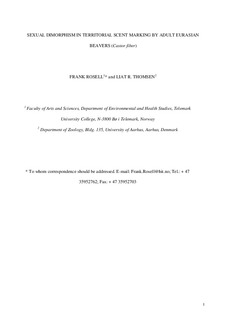| dc.description.abstract | Mammalian scent marking is often associated with territorial defense. However, males and females may demonstrate different activity patterns and play different roles. Female mammals nurture the young during lactation, while males purportedly perform other tasks more frequently, such as territorial maintenance and defense. This paper investigates the contribution made by mated pairs of adult males and females to territorial scent-marking in the obligate monogamous Eurasian beavers (Castor fiber). We hypothesized that both sexes should show territorial behavior, and predicted that they deposit a higher proportion of scent marks at borders. We also hypothesized that a sexual dimorphism exists due to reproductive constraints on the females, and predicted that males should invest significantly more in scent-marking behavior than females during summer. We obtained behavioral data by radio tracking six mated pairs of Eurasian beavers during spring and summer 2000-2001 on two rivers in southeastern Norway. Our results showed that both males and females clustered their scent marks near territorial borders, but males deposited a larger number of scent marks than females and spent more time at borders. Males were also found to have a higher scent marking rate and scent marks per night than females during summer, but not during spring. Overall, scent marks per night were higher in males than females. We conclude that both males and females Eurasian beavers carry out territorial behavior by scent marking, but males carry a larger part of the territorial defense during summer when females lactate. Our results are discussed in the light of the codefense hypothesis. | |
